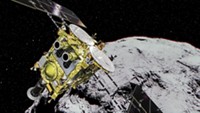Advertisement
Grab your lab coat. Let's get started
Welcome!
Welcome!
Create an account below to get 6 C&EN articles per month, receive newsletters and more - all free.
It seems this is your first time logging in online. Please enter the following information to continue.
As an ACS member you automatically get access to this site. All we need is few more details to create your reading experience.
Not you? Sign in with a different account.
Not you? Sign in with a different account.
ERROR 1
ERROR 1
ERROR 2
ERROR 2
ERROR 2
ERROR 2
ERROR 2
Password and Confirm password must match.
If you have an ACS member number, please enter it here so we can link this account to your membership. (optional)
ERROR 2
ACS values your privacy. By submitting your information, you are gaining access to C&EN and subscribing to our weekly newsletter. We use the information you provide to make your reading experience better, and we will never sell your data to third party members.
Physical Chemistry
Water, Water Everywhere—Even On The Moon
Space Science: Researchers confirm that there is water on the moon
by Elizabeth K. Wilson
November 13, 2009

When the National Aeronautics and Space Administration's LCROSS spacecraft plunged to the moon's surface last month, the impact kicked up about 100 kg of water in the camera's field of view—enough to fill a dozen or so two gallon buckets, scientists reported today at a press conference.
The spacecraft targeted the permanently shadowed crater Cabeus near the moon's south pole, where scientists have suspected water ice might be able to exist. Although the impact failed to generate a dramatic visible plume of debris, LCROSS's instruments found plenty of evidence for water from two key areas of the spectrum: infrared and ultraviolet. Shortly after the impact, the infrared spectrometer identified spectral dips unique to water, and the ultraviolet spectrum showed a sharp peak corresponding to the hydroxyl radical, which is also associated with water. "This is a really strong detection," said Anthony Colaprete, LCROSS mission project scientist at NASA Ames Research Center in Moffett Field, Calif.
"What an exciting and extraordinary discovery this really is," said Greg Delory, LCROSS mission team scientist at the University of California, Berkeley. "Equally important is what to do next: Where did the water come from? And how long has it been there?"
Possible sources include comets, or chemical reactions with solar wind, Delory said.





Join the conversation
Contact the reporter
Submit a Letter to the Editor for publication
Engage with us on Twitter